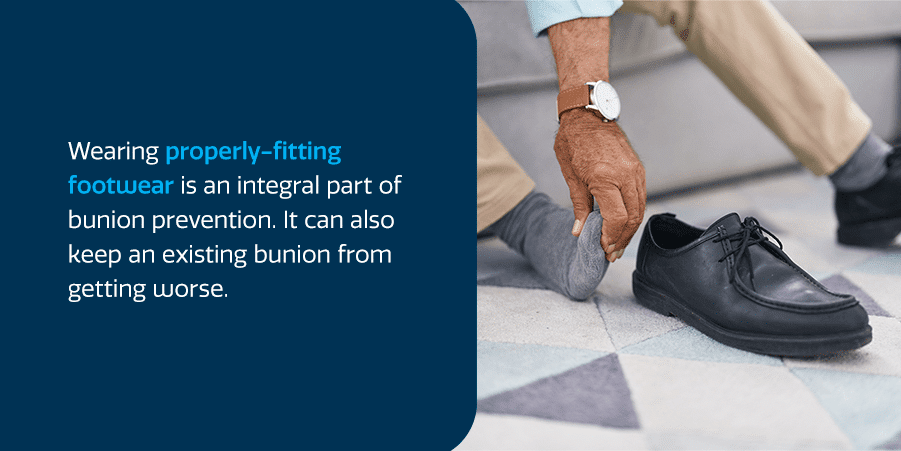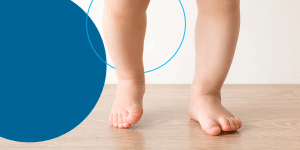Are you living with a painful, bony protrusion on the side of your big toe? You may have what’s known as a bunion. While these foot conditions are common, they can interfere with your ability to live a normal life, causing swelling, discomfort and even trouble walking if they progress.
The good news is many bunion treatments are available, as well as ways to help prevent them in the future. Read on to learn about each.
What Are Bunions?
A bunion is a bony lump that forms on the outside of the big toe at the joint connecting it to the foot. Bunions occur when some of the bones in this area shift out of place, causing the big toe to point inward and the joint at the base of the big toe to protrude outward.
Bunions occur slowly due to years of pressure on the big toe joint. They are more common in older adults, particularly women.
In addition to a hard, bulging lump on the outside of the big toe, signs and symptoms of a bunion may include:
- Swelling, redness and pain around the big toe.
- Pain that is constant or comes and goes.
- Limited ability to move the big toe.
- Pain or burning when you try to bend the big toe.
- Numbness in the big toe.
- Calluses where the toes rub against each other.
- Hardened skin on the sole of the foot.
What Causes Bunions?
While doctors are unsure of the exact cause, the following factors may contribute to bunion development:
- Foot injuries or stress
- Inherited foot shape and structure
- Foot deformities present at birth
- Inflammatory conditions such as rheumatoid arthritis
- Wearing ill-fitting shoes, particularly those with a narrow toe box
Types of Bunions
Bunions on the big toe that occur in adulthood are most common, but other types include the following:
- Congenital bunions: These bunions are present at birth.
- Adolescent bunions: These bunions affect children and teenagers between 10 and 15 years old.
- Tailor’s bunion: Also known as bunionettes, these bunions develop on the outside of the pinky toe.
Problems Bunions Can Cause
Bunions can cause complications, including the following:
- Bursitis: Bursitis occurs when the fluid-filled sacs that protect the bones near your joints become swollen.
- Hammertoe: Hammertoe is an abnormal bend in the middle joint of a toe, usually the second toe, that can cause pressure and discomfort.
- Metatarsalgia: This condition causes swelling and pain in the ball of your foot.
- Osteoarthritis: Bunions cause a chronic abnormal joint position, which can lead to osteoarthritis.
What Is the Outlook for People With Bunions?
Bunions can worsen over time if you don’t properly care for them. If bunions make standing and walking too uncomfortable, you may become sedentary, further diminishing your overall health and quality of life. For these reasons, it’s important that you take steps to slow bunion progression.
If you have bunions, the treatments below can help minimize symptoms and allow you to live a comfortable, active lifestyle.
Bunion Treatments
Bunions are often treatable without surgery. However, they won’t go away on their own, so nonsurgical bunion treatment aims to lessen pain and prevent the bunion from progressing. Try the following measures for how to fix bunions:
- Proper footwear: Shoes with a generous toe box that doesn’t compress the toes can help relieve pressure on a bunion. You can also make more toe room in tight shoes with a stretching tool.
- Padding: Placing silicone pads inside your shoe can help cushion the bunion. You can purchase protective pads at a pharmacy. You may need to try a few different sizes to find one that fits correctly.
- Orthotics: Orthotics are custom-made or over-the-counter shoe inserts that support problem areas in your feet. These can be especially helpful if you have flat feet or another structural foot problem.
- Other devices: Braces, splints and toe spacers can help straighten your toe and relieve pain.
- Medication: Nonsteroidal anti-inflammatory drugs like ibuprofen and naproxen can help reduce swelling and ease pain.
Your doctor may recommend surgery if nonsurgical treatments don’t help or if the pain interferes with walking. A bunionectomy is a common surgery to correct bunions. In this procedure, the surgeon removes the bunion and repositions the bones to align the big toe properly.
Bunion surgery is typically a minor procedure that doesn’t require a hospital stay. Following the surgery, you may be able to wear a stiff-soled shoe and bear weight on the foot, or you may need a brief period of immobilization with no weight on the foot.
Can You Prevent Bunions?
Wearing properly-fitting footwear is an integral part of bunion prevention. It can also keep an existing bunion from getting worse. Your shoes should have a wide toe area and cushioned soles. Avoid tight or sharply pointed shoes and heels higher than two inches.

The following tips can help you choose shoes that fit correctly:
- Shoe sizes can vary between brands and styles. Select a shoe size based on how it feels on your foot rather than the marked size.
- Choose shoes that closely contour to your foot’s shape.
- Your feet can change in size as you age, so have them measured regularly, and at the end of the day when they are largest. Be sure to measure both feet because one foot can often be larger than the other. Choose shoes in the larger foot’s size.
- As you try on shoes, stand up and ensure there is 3/8 to 1/2 inch of space between your longest toe and the end of the shoe.
- Ensure that the ball of your foot fits comfortably in the widest part of the shoe.
- Make sure your heel slides easily into the shoe and there’s minimal slippage when you walk.
- Do not buy tight shoes expecting them to stretch to a comfortable fit as you wear them.
Get Bunion Treatment at Foot & Ankle Surgical Associates
Bunions can cause pain that may make daily activities difficult, such as exercising, doing chores and anything else that keeps you on your feet. But life doesn’t have to slow down because of a bunion — Foot & Ankle Surgical Associates can help treat your foot condition so you can return to the life you want.
We understand how debilitating bunions and other foot problems can be, and that’s why our providers are highly skilled at diagnosing and treating foot and ankle problems. Our podiatry services include orthotics, physical therapy and surgery to treat a range of ankle, heel and foot concerns.
If you have ankle, heel or foot pain in Lacey, Olympia, Tumwater, Tacoma or Centralia, call the Foot & Ankle Surgical Associates at 360-754-3338 today to schedule a podiatry appointment. We look forward to helping ease your pain!





